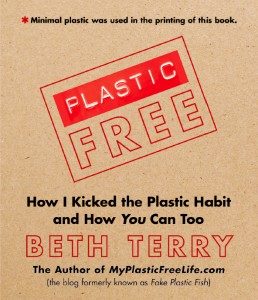 How much money do you waste buying plastic every year? It’s probably hundreds, if not thousands of dollars. Even though it’s that much money, you may not realize how much you’re spending because so much of the plastic we buy is hidden in products that we think are plastic-free. Fortunately, by following even a third of the suggestions in this new must-read book from plastic-free visionary Beth Terry, you can start saving a lot of that money rather than throwing it away. You might even save enough to put your child through college!
How much money do you waste buying plastic every year? It’s probably hundreds, if not thousands of dollars. Even though it’s that much money, you may not realize how much you’re spending because so much of the plastic we buy is hidden in products that we think are plastic-free. Fortunately, by following even a third of the suggestions in this new must-read book from plastic-free visionary Beth Terry, you can start saving a lot of that money rather than throwing it away. You might even save enough to put your child through college!
But let’s back up a minute, to the original question. How much money do you waste buying plastic every year? I’ve written about why using less plastic matters here. In short, the stuff is made from oil and other toxic chemicals, can make us sick if we’re repeatedly exposed to those chemicals, and wreaks havoc on wildlife and the environment.
If you’ve given up buying bottled water, use your own reusable cloth shopping bag and maybe grow some (or most) of your own food, your automatic response might be: “Almost none. I don’t buy plastic.”
But chances are, you’re still subsidizing the use of a fair amount of plastic, since almost everything anyone buys these days comes either shrink-wrapped, padded in plastic balls or peanuts (yes, polystyrene is a form of plastic), encased in a plastic package of some sort, or wrapped in paper that’s been coated with a plastic film so thin you don’t even notice it.
One area where I’ve become particularly aware of how much plastic I consume is in the bathroom. Even though I don’t use a lot of cosmetics and follow a mostly “natural” hygiene regimen, now that I’m paying attention, I’m appalled at how many of my personal care products come packaged in plastic. I’ve switched to bar soap that’s sold either wrapper free or wrapped in paper, my face cream comes in glass jars, and my hand salve comes in metal tins. I use wash cloths instead of disposable wipes to remove dirt and make-up, and a crystal for deodorant. But my shampoo, conditioner, body lotion, toothpaste, sunscreen, and mouthwash? They’re all packaged in plastic. Ditto for the blush, mascara and lip gloss I apply.
The kicker is, I’m not buying a lot of conventional products. What I buy is always free of parabens, phthalates, synthetic fragrances, and triclosan, as well as many other questionnable chemicals I’d rather not put on my body or wash down the drain. Because most of these items come in jars and tubes made from recycled plastic, I used to think that was good enough, since I can easily recycle them in my city’s curbside recycling program.
Beth, whose expertise I admire enormously, has done the research, and she says that, in most cases, the best plastic is no plastic at all, recycled or not. I recommend you read her book yourself to understand why. Let me just say that I’ve been so persuaded by her reporting that I’ve decided to embark on an effort to try many of the plastic-free alternatives she suggests, including several of her make-it-yourself recipes. (Come back soon to see how her home-made shampoo and conditioner recipes did on my hair.)
At Big Green Purse, we recommend shifting your spending to the safest, greenest products available as the fastest, easiest way to protect yourself and your family while giving manufacturers real marketplace incentives to do better, too. (Read this post about how Beth shifted more than $1,000 to all kinds of great green goods as part of our One in a Million campaign!).
How big an impact can you have, if you just focused on beauty products? According to the YWCA report “Beauty at Any Cost,” five years’ worth of beauty products costs about $6,423 on average. One full year of college tuition and fees at a public in-state college is $6,185! Neither I nor Beth are recommending you stop using any of these products at all. But if you spend over $1,000 a year on personal care products, think of the impact you can have by shifting your spending to products packaged in glass or paper, or by making your own rather than buying so much. Whether you shift a dime or a dollar, you can make a difference.
I hope you’ll read this book, and not just because of what you do in your bathroom. Beth examined her entire lifestyle to figure out where she was using plastic and how she could cut back. The results are incredibly inspiring. “In the years since my plastic awakening,” she writes, “ I’ve gone from personally generating almost four pounds of plastic waste per month to a little over two pounds per year (the average American generates between 88 and 120 pounds per year), and I am continuing the downward trend. While I’ve learned many facts about plastic—how it’s made, which types leach toxic chemicals into our food, why plastic recycling is actually “down- cycling,” and the many ways in which it’s both helpful and harmful—the biggest lessons have been personal rather than factual.”
She acknowledges that “It’s nearly impossible to eliminate plastic from our lives entirely. And, unlike me, you may not even want to try. That’s OK. This isn’t a competition, and I don’t hold myself up as an ideal.”
Here’s what I especially like about Beth’s philosophy: “The goal is to be aware and responsible,” she says without the least bit of preachiness. “You might find yourself saying, “I know this is plastic and bad for the environment (and for my health), but I really need it or want it right now.” You think about the consequences, weigh your options, and make a decision. Other times, you may say to yourself, “It might be nice to have this, but it just isn’t worth the pollution and health risks. I can do without it.” Perhaps you will set a goal—to reduce your plastic consumption by a certain percentage or keep it under a certain amount per month. Or you might define what constitutes an emergency situation for you, and save plastic for those times. Whatever you do, it will be your choice.” What a great attitude!
JUST FOR FUN!
In addition to all the great background information and straightforward action checklists, Beth provides some surprising insights into the ways she’s had fun going plastic-free. I love her suggestion for a “make your own” iPod cover:
“What do you do when your iPod cover cracks and you need a new one and all you can find to buy are covers made out of plastic or handmade covers from Etsy that just don’t fit your lifestyle and the way you want to use your device? This might seem like a silly concern when the mp3 player itself is made from plastic, but my plastic-free life is not about deprivation but finding creative ways to enjoy the possessions I already have without buying new plastic.
“So one night, when I was supposed to be working on a million other things, I entertained myself by devising my perfect knitted iPod cover, complete with holes for the power cord and headphone jack and openings for viewing the screen and accessing the click wheel. I felt pretty tickled with myself, and even more so a year later when the foam pads on a couple pairs of headphones wore out and I taught myself to crochet in order to make some plastic-free replacements out of wool. I feel a real connection to and appreciation for items I’ve spent hours making myself. I also feel much more motivated to take care of them properly. Whenever I need something new, I check Google first to see if someone has come up with a handmade version or instructions for doing it myself. I’m not always willing to take the time, but when I do, it’s always worth it.”
Beth is selling signed copies of her book through her blog to benefit the Plastic Pollution Coalition. Plus, any copies Beth sends out or that are purchased via BuyGreen.com are guaranteed to ship without plastic packaging. Get a copy for yourself, for your friends, and for community leaders who think there’s no way to live without plastic. Beth’s book proves them wrong from the very first page to the last.


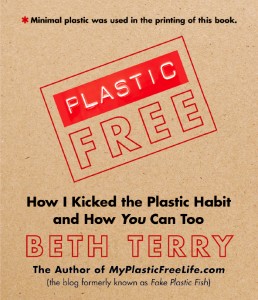

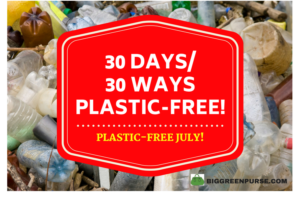
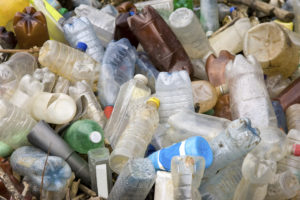
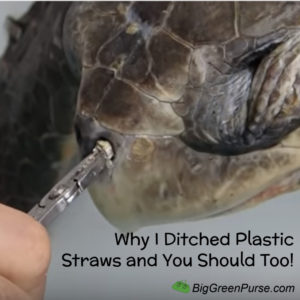

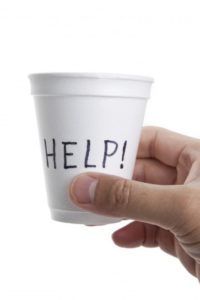
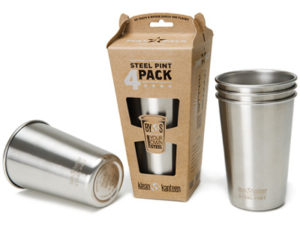








9 thoughts on “Want a Plastic-Free Life? Buy This Book ASAP!”
I’m in the middle of the book and blown away by the information Beth provides and how we have become so attached to plastic in such a relatively short time. It’s a book that is making me think and making me act and I don’t know what else you can ask from a book.
Interesting stuff. I travel a lot for work, and I’m conscious of the amount of damage to the environment that my travel is doing. I try to reduce the amount of waste I produce in other areas, but as I type this, I’m drinking out of a plastic bottle and consuming a snack that came in a plastic wrapper. I try to buy food from the local butcher more often than from the supermarket (he wraps stuff in paper), but I guess I have a long way to go.
I can’t wait to read this – I have been following Beth for so long and it’s super exciting that she has a book now so that more people can learn this important information. I love your tip about the iPod cover and how cool that she is shipping them without plastic! Thanks to you as well for all the amazing information you provide – you’re both very inspiring!
Beth is truly an inspiration to all of us!
I’m really looking forward to reading the book. I recently switched to using paper tape for shipping and I am really happy with it.
Wow, Diane, what a great review! That is amazing how much is spent on beauty products every year. I’ve switched to a shampoo bar from Etsy that is shipped plastic free (except the tape, I guess), but still searching for a conditioner/ leave-in conditioner I feel good about using. One step at a time.
Reading just the cover page of the book is already very interesting. Beth’s information could be a wake-up call for everyone of us to join green movement advocacy on sustainable development. I would recommend this book to everyone.
I’m drinking out of a plastic bottle and consuming a snack that came in a plastic wrapper. I try to buy food from the local butcher more often than from the supermarket (he wraps stuff in paper), but I guess I have a long way to go.
I looked at your website. None of the plastic bottles you sell seem to be free of BPA. If you’re going to sell plastic bottles, can’t you at least make them the healthiest option available?!
Comments are closed.